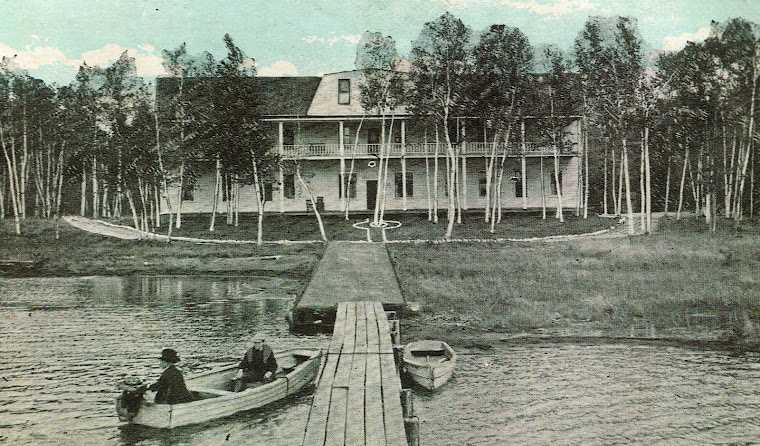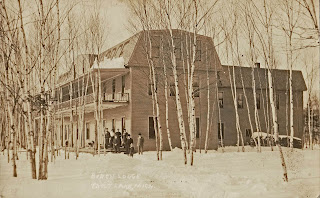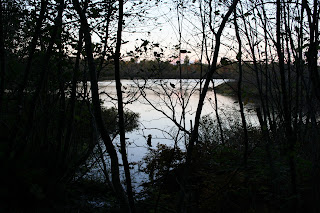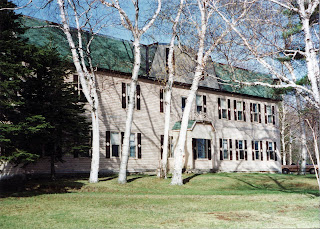
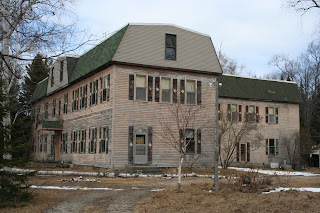 |
| Birch Lodge before Restoration |
We closed on the lodge just before Memorial Day, and spent that weekend settling into the small log cabin which would be our base for the summer. A tree had fallen on the electrical mast of the motel, and repairs were needed before we were ready to house the workers for the work on the lodge. Trees were down everywhere, the lawn had not been mowed in quite a while, and the lake edge was sprouting tag alder. Junk and debris had accrued everywhere. (Over twenty truckloads were cleaned up this year, not counting construction debris.)
And the lodge....
Oh, the lodge, the poor lodge, it looked really sad. On top of needing paint, and a roof the foundation was crumbling in the front and it was sagging.
Work on the lodge itself finally began in July. Our objective was to get a new roof on, make the repairs to the foundation, restore the old windows, and give it a coat of paint so that it might be weather-tight, and stabilized until further work inside can be done.
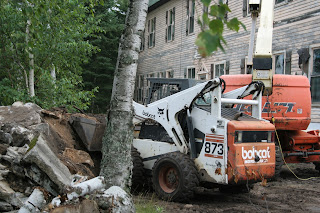 |
| Demolition |
The worst area was in the front of the lodge, under the picture windows in the lobby, where the building had sagged. Before the foundation was repaired, this area was raised almost 5", and support beams were installed, until the new foundation work was installed. It groaned, and moaned, cracked and popped, and at one point, the men thought it would not lift, but finally it started to move and all was well. Surprisingly, this did very little additional damage to the plaster inside.
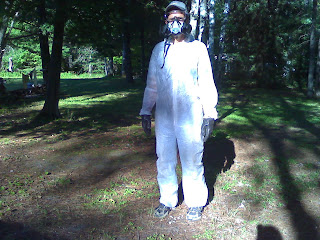 |
| Bill in Protective Gear |
Bill got to don a respirator, and tyvek suit to tackle the clean-up of the bat droppings in the attic. Oddly, no bats were found in the attic, just their calling cards... the attic was then repeatedly sprayed with a bleach solution before the window restorers set to work.
 |
| Roofing Birch Lodge |
The re-roof involved stripping off the old shingle and felt, which exposed the old roof boards. Originally, the roof had cedar shakes, which were nailed on boards with gaps between them to allow the air to flow. Unfortunately, when they were torn off and re-done way back when, they did not add any additional fill strips in the boards, and the old shingles were only "nailed" to the roofing felt over much of the roof! The view outside from the attic looked like a planetarium--a thousand points of light!
New sheathing went on as the weather turned rainy, and sections of roof were done quickly as the rain allowed. This was a dismal process, the rain seemed to play tag with the workers. The only good thing about doing a roof in rainy summer is that it makes it easy to check for leaks! (The only areas which leaked were "in progress" spots.)
In the midst of the work, the visitors came, by car, boat, golf cart--and wheel chair. It was fun to watch the parade of boats, and kayaks, and even jet-ski's watching us. One morning as the black underlayment for the roof was up across the front a jet-ski screamed across the lake, paused at the shore, apparently saw that it was only black on the roof because it was in progress, and darted straight back!
I wish I had a dollar for everyone who told us where to put the dock in (straight off the front door!). But we did enjoy listening to the stories people shared. We were deeply moved when one of our older visitors actually came to tears, she was so happy that we were saving the lodge. It did wonders for our spirits to get such strong approval.
But in spite of the numerous requests, we have no plans at this time to re-open the Birch Bar. Eventually I hope if will be open for coffee, but it will remain intact pool table and jukebox, and the bar with all their initials carved in, just the same. I invite all with old photos of vacations at the lodge to send us a copy, I intend to frame groups of old photos along the walls for all to reminisce and enjoy.
Next the story of the windows....


